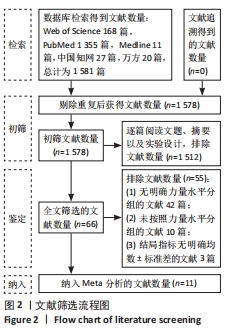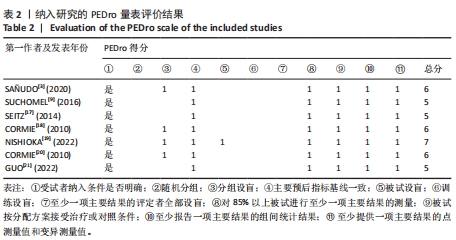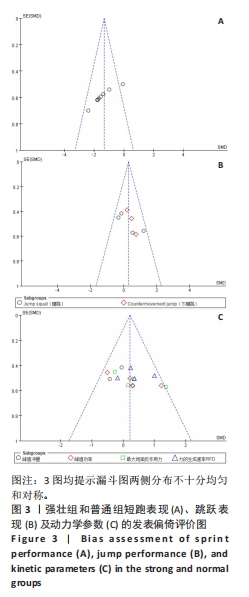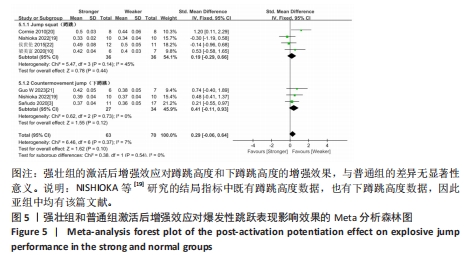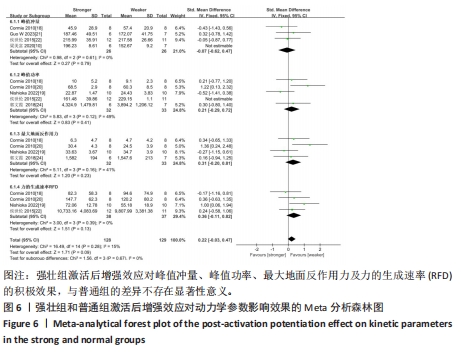[1] TILLIN NA, BISHOP D. Factors modulating post-activation potentiation and its effect on performance of subsequent explosive activities. Sports Med. 2009;39(2):147-166.
[2] GOŁAŚ A, MASZCZYK A, ZAJAC A, et al. Optimizing post activation potentiation for explosive activities in competitive sports. J Hum Kinet. 2016;52(9):95-106.
[3] SAÑUDO B, DE HOYO M, HAFF GG, et al. Influence of strength level on the acute post-activation performance enhancement following flywheel and free weight resistance training. Sensors (Basel). 2020;20(24):7156-7164.
[4] AANDAHL HS, VON HEIMBURG E, VAN DEN TILLAAR R. Effect of postactivation potentiation induced by elastic resistance on kinematics and performance in a roundhouse kick of trained martial arts practitioners. J Strength Cond Res. 2018;32(4):990-996.
[5] 王安利,张新.力量训练的理论探索及实践进展:后激活增强效应的影响因素及应用[J].中国学校体育(高等教育),2014,1(11):79-83.
[6] RUBEN RM, MOLINARI MA, BIBBEE CA, et al. The acute effects of an ascending squat protocol on performance during horizontal plyometric jumps. J Strength Cond Res. 2010;24(2):358-369.
[7] GONZÁLEZ-GARCÍA J, LATELLA C, AGUILAR-NAVARRO M, et al. Effects of resistance priming exercise on within-day jumping performance and its relationship with strength level. Int J Sports Med. 2023;44(1):38-47.
[8] MCBRIDE JM, DAVIE A. A comparison of strength and power characteristics between power lifters, olympic lifters, and sprinters. J Strength Cond Res. 1999;13(13):58-66.
[9] SUCHOMEL TJ, SATO K, DEWEESE BH, et al. Potentiation following ballistic and nonballistic complexes: the effect of strength level. J Strength Cond Res. 2016;30(7):1825-1833.
[10] 梁美富,张怀川,张树峰,等.不同力量水平运动员激活后增强效应的时域特征[J].上海体育学院学报,2020, 44(6):54-61.
[11] SLOTH M, SLOTH D, OVERGAARD K, et al. Effects of sprint interval training on VO2max and aerobic exercise performance: a systematic review and meta-analysis. Scand J Med Sci Sports. 2013;23(6):e341-e352.
[12] 吴旸,李倩,包大鹏.加压力量训练对下肢骨骼肌影响的Meta分析[J].中国体育科技,2019,55(3):20-26.
[13] MAHER CG, SHERRINGTON C, HERBERT RD, et al. Reliability of the PEDro scale for rating quality of randomized controlled trials. Phys Ther. 2003;83(8):713-721.
[14] STERNE JA, HERNÁN MA, REEVES BC, et al. ROBINS-I: a tool for assessing risk of bias in non-randomised studies of interventions. BMJ. 2016;355:i4919.
[15] 刘伊依,邱俊强,衣龙燕,等.接受抗阻训练中老年人白细胞介素6与C-反应蛋白变化的Meta分析[J].中国组织工程研究,2022,26(5):804-812.
[16] ENG C, KRAMER CK, ZINMAN B, et al. Glucagon-like peptide-1 receptor agonist and basal insulin combination treatment for the management of type 2 diabetes: a systematic review and meta-analysis. Lancet. 2014;384(9961):2228-2234.
[17] SEITZ LB, DE VILLARREAL ES, HAFF GG. The temporal profile of post activation potentiation is related to strength level. J Strength Cond Res. 2014;28(3):706-715.
[18] CORMIE P, MCGUIGAN MR, NEWTON RU. Changes in the eccentric phase contribute to improved stretch-shorten cycle performance after training. Med Sci Sports Exerc. 2010;42(9):1731-1744.
[19] NISHIOKA T, OKADA J. Influence of strength level on performance enhancement using resistance priming. J Strength Cond Res. 2022;36(1):37-46.
[20] CORMIE P, MCGUIGAN MR, NEWTON RU. Influence of strength on magnitude and mechanisms of adaptation to power training. Med Sci Sports Exerc. 2010;42(8):1566-1581.
[21] GUO W, LIANG M, LIN J, et al. Time duration of post-activation performance enhancement (PAPE) in elite male sprinters with different strength levels. Children (Basel). 2022;10(1):53-62.
[22] 侯世伦,张新,王安利.下肢力量与负荷后恢复时间对后激活增强效应的影响[J].北京体育大学学报,2015, 38(5):57-62.
[23] JAMES LP, GREGORY HAFF G, KELLY VG, et al. The impact of strength level on adaptations to combined weightlifting, plyometric, and ballistic training. Scand J Med Sci Sports. 2018;28(5):1494-1505.
[24] 郭文霞,曲淑华,孔振兴,等.以时域特征为视角的骨骼肌激活后增强效应[J].中国组织工程研究,2018, 22(24):3804-3810.
[25] MANNING DR, STULL JT. Myosin light chain phosphorylation-dephosphorylation in mammalian skeletal muscle. Am J Physiol. 1982;242(3):234-241.
[26] VANDERVOORT AA, QUINLAN J, MCCOMAS AJ. Twitch potentiation after voluntary contraction. Exp Neurol. 1983;81(1):141-152.
[27] BROWN IE. post activation potentiation a clue for simplifying models of muscle dynamics. American Zoologist. 1998;38(4):743-754.
[28] SEITZ LB, HAFF GG. Factors modulating post-activation potentiation of jump, sprint, throw, and upper-body ballistic performances: a systematic review with meta-analysis. Sports Med. 2016;46(2):231-240.
[29] WILSON JM, FLANAGAN EP. The role of elastic energy in activities with high force and power requirements: a brief review. J Strength Cond Res. 2008;22(5):1705-1715.
[30] JO E, JUDELSON DA, BROWN LE, et al. Influence of recovery duration after a potentiating stimulus on muscular power in recreationally trained individuals. J Strength Cond Res. 2010;24(2):343-347.
[31] SEITZ LB, REYES A, TRAN TT, et al. Increases in lower-body strength transfer positively to sprint performance: a systematic review with meta-analysis. Sports Med. 2014; 44(12):1693-1702.
[32] COMFORT P, HAIGH A, MATTHEWS MJ. Are changes in maximal squat strength during preseason training reflected in changes in sprint performance in rugby league players? J Strength Cond Res. 2012;26(3):772-776.
[33] HARRIS GR, STONE MH, O’BRYANT HS. Short-term performance effects of high power, high force, or combined weight-training methods. J Strength Cond Res. 2000;14(1):14-20.
[34] 梁美富,郭文霞,孔振兴,等.激活后增强效应的间歇时间对下蹲跳高度影响的Meta分析[J].武汉体育学院学报,2018,52(2):49-56.
[35] GIRMAN JC, JONES MT, MATTHEWS TD, et al. Acute effects of a cluster-set protocol on hormonal, metabolic and performance measures in resistance-trained males. Eur J Sport Sci. 2014;14(2):151-159.
[36] ZAMPARO P, MINETTI AE, DI PRAMPERO PE. Interplay among the changes of muscle strength, cross-sectional area and maximal explosive power: theory and facts. Eur J Appl Physiol. 2002;88(3):193-202.
[37] ESFORMES JI, BAMPOURAS TM. Effect of back squat depth on lower-body postactivation potentiation. J Strength Cond Res. 2013;27(11):2997-3000.
[38] GOURGOULIS V, AGGELOUSSIS N, KASIMATIS P, et al. Effect of a submaximal half-squats warm-up program on vertical jumping ability. J Strength Cond Res. 2003;17(2):342-344.
[39] REQUENA B, GAPEYEVA H, GARCÍA I, et al. Twitch potentiation after voluntary versus electrically induced isometric contractions in human knee extensor muscles. Eur J Appl Physiol. 2008;104(3):463-472.
[40] SALE DG. Postactivation potentiation: role in human performance. Exerc Sport Sci Rev. 2002;30(3):138-143.
[41] GILBERT G, LEES A. Changes in the force development characteristics of muscle following repeated maximum force and power exercise. Ergonomics. 2005;48(11-14): 1576-1584. |

